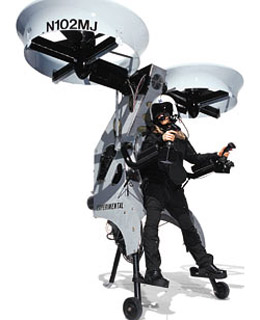
Everybody dreams of flying. Leonardo da Vinci sketched dozens of prototypes for flying machines based on the anatomy of birds. The Wright brothers finally worked out the details four centuries later. Yet even in this age of space shuttles, supersonic jets and ultralight airplanes, the quest to build the perfect personal flying machine still lures the world's inventors. Nobody is pursuing the dream of solo flight with more fervor than two Americans, Paul Moller and Michael Moshier. They have very different ideas of what a personal flyer should look like, but each is equally convinced that his vision—decades in the works—is about to come true.
"I know in my heart that this technology is coming, and if I don't do it someone else will," says Moller, a mechanical and aeronautical engineer who has devoted nearly 40 years and $200 million to developing his flying car. Someday, he believes, people will launch Skycars from their rooftops and fly to work. His first model, built in 1962, looked like a flying saucer and never got off the ground. The current iteration, the M400, is painted hot-rod red and shaped like a miniature fighter plane. It is powered by eight 150-horsepower methanol-burning rotary engines, has a state-of-the-art, microprocessor-controlled steering system for increased stability and can reach top speeds of 350 m.p.h.—at least in theory. While no one outside the company has ever seen the Skycar fly, Moller claims it hovered about 10 ft. above the ground for a few seconds in a test flight last month.
Moshier's Solotrek XFV (short for Exo-Skeletor Flying Vehicle) has a comparable flight record: 8 in. above the ground for about 9 sec., according to the inventor. A former Navy combat pilot, Moshier has been working on his creation, at least in his mind, since he was a teenager in the 1960s, although officially his company, Millennium Jets, has been at it only six years. The look of his machine is pure sci-fi: an 8-ft. metal frame supports two gas-engine-powered fans, each 38 in. in diameter, that jut like oversize ears above the frame. The pilot stands on a pair of footrests, straps on a body belt and grabs a joy stick like controller. Moshier says the Solotrek will someday travel 8,000 ft. above the trees at up to 80 m.p.h. "There are lots of nonbelievers," he admits. "But I always knew we could do this." Somebody at the Defense Department must agree; the Pentagon has invested $5 million in the project, and nasa's Ames Research Center has offered Moshier the use of its wind tunnels.
Will either machine ever fly? Probably, given enough time and funding. Whether they will ever take off as an alternative to the commuter car is another matter. Would you fly one to work?